
Hướng dẫn học tiếng Anh 9 Unit 8: Tourism
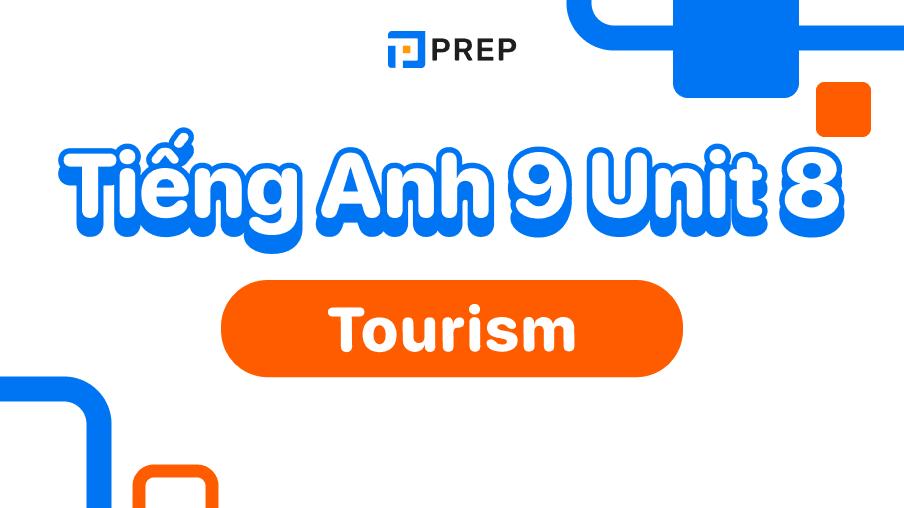
I. Giới thiệu về Unit 8 tiếng Anh 9
Trước soạn tiếng Anh 9 Unit 8, hãy cùng PREP điểm danh qua phần “Book Map” ngay dưới đây bạn nhé!
Tham khảo thêm bài viết:
-
Tiếng Anh 9 Unit 7: Healthy living for teens - Global Success
-
Tiếng Anh 9 Unit 9: World Englishes - Global Success
-
Tiếng Anh 9 Review 3 | Language và Skills
II. Từ vựng, ngữ pháp, phát âm trọng tâm trong Unit 8 tiếng Anh 9
Cùng PREP điểm qua kiến thức về từ vựng, ngữ pháp, phát âm trọng tâm trong Unit 8 tiếng Anh 9 dưới đây nhé!

1. Từ vựng
Cùng PREP điểm danh phần từ vựng chủ đề Du lịch trong Tiếng Anh 9 Unit 8 dưới đây bạn nhé!
2. Ngữ pháp
Đại từ quan hệ trong tiếng Anh (Relative pronouns) là một loại đại từđược sử dụng để thay thế cho một danh từ hoặc một cụm danh từ trong một câu, và nó liên kết câu đó với một mệnh đề phụ (mệnh đề quan hệ). Có 5 loại đại từ quan hệ chính trong tiếng Anh, đó là: who, whom, whose, which, và that. Ví dụ:
-
The boy who broke the window has to pay for it. (Cậu bé đã làm vỡ cửa sổ phải đền tiền.)
-
The house whose roof is green is for sale. (Ngôi nhà có mái màu xanh đang được rao bán.)
3. Phát âm
-
Khi một từ kết thúc bằng -ic, trọng âm thường rơi vào âm tiết ngay trước đuôi -ic. Ví dụ:
-
Academic /ˌækəˈdemɪk/ (trọng âm rơi vào âm tiết thứ hai: dem)
-
Electric /ɪˈlɛktrɪk/ (trọng âm rơi vào âm tiết thứ hai: lec)
-
Graphic /ˈɡræfɪk/ (trọng âm rơi vào âm tiết thứ nhất: gra)
-
-
Khi một từ kết thúc bằng -ious, trọng âm thường rơi vào âm tiết ngay trước đuôi -ious.
-
Serious /ˈsɪəriəs/ (trọng âm rơi vào âm tiết thứ nhất: se)
-
Curious /ˈkjʊəriəs/ (trọng âm rơi vào âm tiết thứ nhất: cur)
-
Previous /ˈpriːviəs/ (trọng âm rơi vào âm tiết thứ nhất: pre)
-
III. Cấu trúc bài học Unit 3 tiếng Anh 9
Cùng PREP điểm qua cấu trúc bài học và nội dung kiến thức có trong Unit 3 tiếng Anh 9 bạn nhé!
1. Tiếng Anh 9 Unit 8 Getting started
1.1. Listen and read
Nghe và đọc.
Tom: Hi, An.
An: Hi, Tom. You've got a nice tan.
Tom: Well, I've just got back from Bali.
An: Bali? Where is it?
Tom: It's in Indonesia. My family flew there for a holiday, and we spent most of the time on the beach. That's how I got this tan.
An: Awesome. Tell me more about Bali.
Tom: Sure It's an ideal destination for holidaymakers, especially those who love the sea.
An: It must be beautiful!
Tom: Very. It's well-known for its natural beauty, sunny beaches, and terraced fields.
An: Is it expensive to travel there?
Tom: Not really. My father was able to buy cheap air tickets and rent a cheap accommodation. He usually uses travel apps for our domestic and international holidays.
An: Where did you stay?
Tom: We stayed in a three-star hotel which is just a ten-minute walk from the sea. Have you been somewhere for holiday?
An: Yeah. Last year my family travelled to Da Nang. We ate different types of local food, and they all were so delicious. My brother said it was a perfect destination for food tourists.
Tom: Yes, I love food tourism, too. There are also other types of tourism like shopping tourism or sports tourism.
An: I didn't know that. Well, I'll try one of those someday.
1.2. Read the conversation again and tick (✔) T (True) or F (False)
Đọc lại đoạn hội thoại và đánh dấu (✔) T (Đúng) hoặc F (Sai).
1.3. Match a word in A with a word in B as in the conversation
Nối một từ ở A với một từ ở B như trong đoạn hội thoại.
1.4. Complete the sentences with the words and phrases from the box
Hoàn thành câu với các từ và cụm từ trong khung.
1. If you go on ______, you can see wild animals in their natural habitat
2. Noi Bai Airport has two terminals: one for international flights and one for ______ flights.
3. You should learn how to use ______ for booking transportation and accommodation.
4. ______ is travelling to watch a sports event.
5. Japan is a must-go ______ for me.
1.5. Quiz
Bạn biết bao nhiêu về du lịch ở Việt Nam?
Work in pairs. Discuss and write the names of the places next to the sentences. (Làm việc theo cặp. Thảo luận và viết tên các địa điểm bên cạnh các câu.)
1. This ancient city in central Vietnam used to be the capital of our country.
2. This city in the South is famous for its floating market.
3. This central highland city usually holds a Flower Festival in December.
4. This northern province has a famous waterfall.
5. This province possesses a World Heritage Site, Ha Long Bay.
2. Tiếng Anh 9 Unit 8 A Closer Look 1
2.1. Match the words and phrases with the explanations
Nối các từ và cụm từ với lời giải thích.
2.2. Write a phrase from the box next to the sentence to replace 'it'
Viết một cụm từ trong hộp bên cạnh câu để thay thế cho 'it'.
1. If you want to go into a place to see what is inside, you have to buy it.
2. The Colosseum in Rome is not in its original condition. You can see only parts of it.
3. It takes care of everything for travellers.
4. I don't like it because I cannot change anything: the time, the destination.
5. We had no trouble at all during it. Everything was OK.
2.3. Complete the sentences with the words from the box
Hoàn thành câu với các từ trong khung.
1. We'd like to go on a(n) _______ tour which will be interesting and be within our budget.
2. Lan sent us the _______ of her trip to Sa Pa for reference.
3. During the tour, we have to buy the _______ tickets for the Glass Museum and the Art Gallery.
4. If you take a(n) _______ holiday, you have to follow a fixed itinerary.
5. If you want to get information about domestic tourist destinations, download these _______.
2.4. Listen and repeat the words. Pay attention to the word stress
Nghe và lặp lại các từ. Hãy chú ý đến trọng âm của từ.
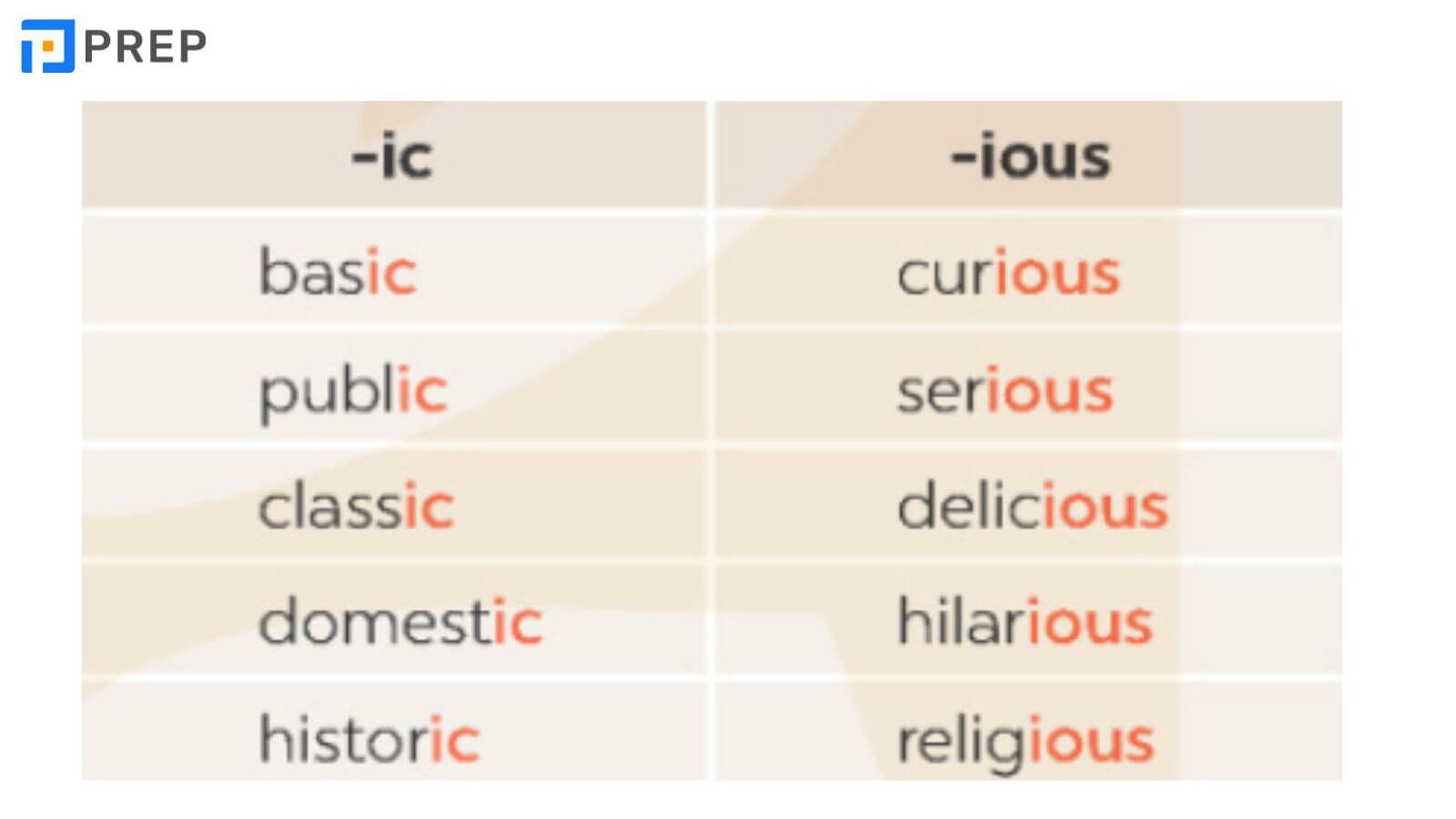
2.5. Mark the stress in the underlined words. Then listen and repeat the sentences
Đánh dấu trọng âm ở những từ được gạch chân. Sau đó nghe và lặp lại các câu.
1. The visitors are curious about the history of the old public building.
2. They have an ambitious goal which is to go on a cruise across the Pacific.
3. We watched some classic movies while we were here on our previous holiday.
4. We stayed at a luxurious hotel near a terrific beach.
5. The village has a romantic landscape with various flower beds.
3. A Closer Look 2
3.1. Underline the noun or noun phrase in each sentence that which or who refers to
Gạch dưới danh từ hoặc cụm danh từ trong mỗi câu mà which hoặc who đề cập tới.
1. People who travel abroad usually use travel apps.
2. The brochure which you can get free at the airport is useful for your stay in Bangkok.
3. Is this the video which explains some new trends in tourism?
4. Could you recommend to me a local tour guide who can speak English?
5. They want to visit a city which is famous for its rich history.
3.2. Underline the correct relative pronoun for each sentence
Gạch dưới đại từ quan hệ đúng cho mỗi câu.
1. This is the brochure which / who provides the information you need for your visit to Beijing.
2. ABC is the company which / who won the Best Travel Agency Award last year.
3. The elders which / who are not good at using online apps prefer package tours.
4. A hop-on hop-off bus which / who runs from here every hour is the fastest way to visit a city.
5. Food tourism is for tourists which / who want to explore the unique dishes of a place.
3.3. Complete each sentence with who or whose
Hoàn thành mỗi câu với who hoặc whose.
1. Mr Minh, _______ will guide us on our Cu Chi Tunnel tour, is on his way.
2. This is the writer _______ book Travel on $50 a Day is my favourite travel guide.
3. My son, _______ is a huge fan of Taylor Swift, is on a music tour to see her in concert.
4. Ha Giang, _______ beauty and history are appealing, is a must-go in my tour list.
5. While travelling, my father often spends time talking with the locals _______ stories, he says, are interesting about the land we are visiting.
3.4. Match a clause in A with a clause in B to make a complete sentence
Nối mệnh đề ở A với mệnh đề ở B để thành câu hoàn chỉnh.
3.5. Work in pairs
Làm việc theo cặp. Thảo luận và hoàn thành câu.
1. Son Doong is now a world-famous destination for travellers who _______.
2. I'm personally against tours which _______.
3. We shared a holiday home with two Germans whose _______.
4. I bought a city map which _______.
5. Most travellers prefer working with tour guides who _______.
4. Tiếng Anh 9 Unit 8 Communication
4.1. Listen and read the conversations
Nghe và đọc đoạn hội thoại. Hãy chú ý đến những phần được đánh dấu.
4.2. Work in pairs
Làm việc theo cặp. Thể hiện nghĩa vụ trong các tình huống sau.
1. You ask your younger brother to make a list of the things he will pack for his holiday so that he does not forget anything. (Bạn yêu cầu em trai mình lập danh sách những đồ đạc sẽ chuẩn bị cho kỳ nghỉ của mình để không quên bất cứ thứ gì.)
2. The teacher asks the class to strictly follow the factory regulations while visiting. (Giáo viên yêu cầu cả lớp tuân thủ nghiêm ngặt nội quy nhà máy khi đến thăm.)
4.3. Read what people say about their travels. Then complete the table
Đọc xem mọi người nói gì về chuyến đi của họ. Sau đó hoàn thành bảng.
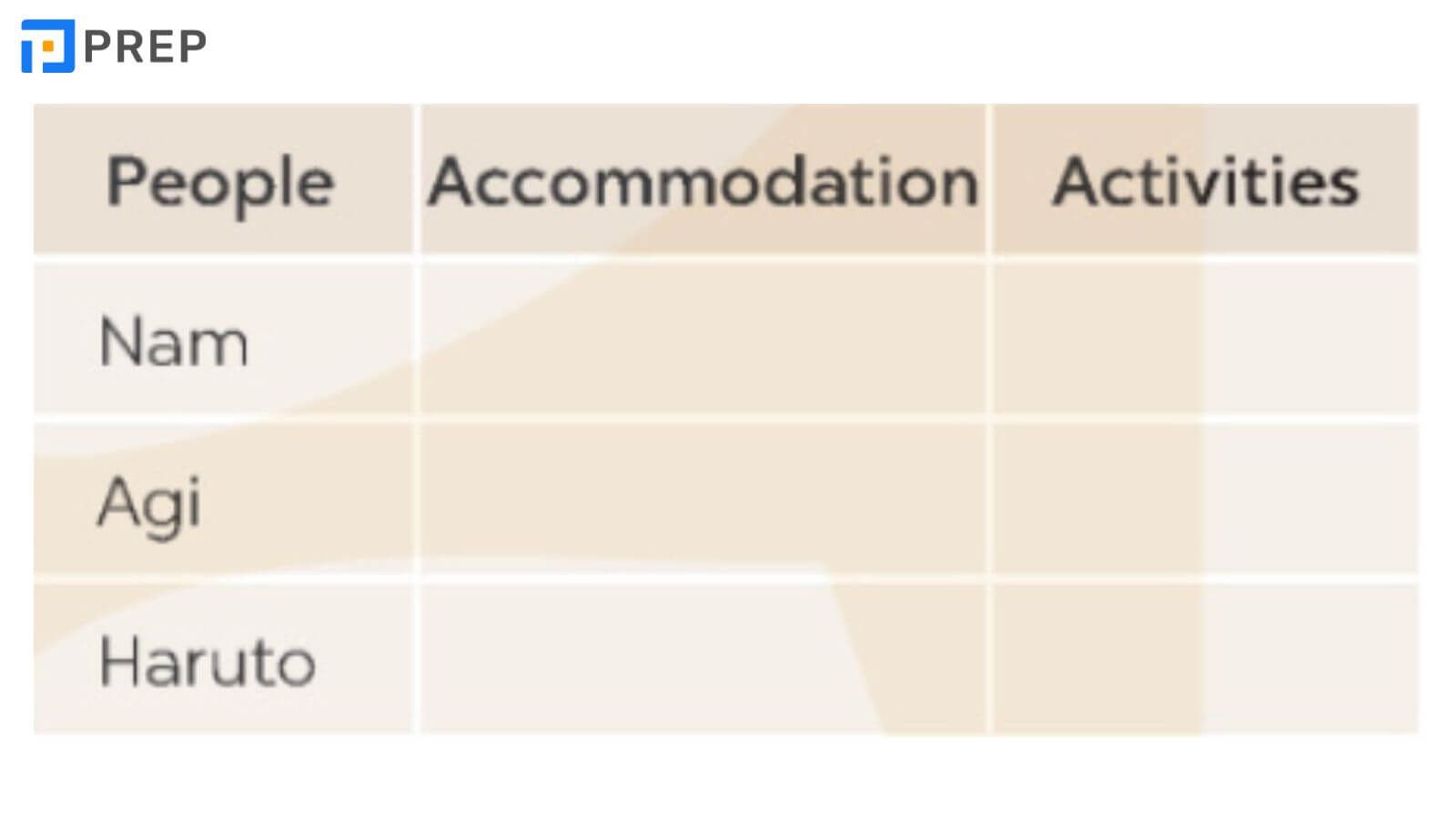
Nam: Last year, my family travelled to Ninh Thuan for a leisure holiday. We rented a homestay by the sea. We swam in the sea and ate the local seafood.
Agi: Next month, my class is going on a trip to Budapest. A travel agency takes care of everything for us. We'll stay in a three-star hotel. We'll visit some cultural places and take a cruise on the Danube River.
Haruto: It was the low season, so my brother and I were able to afford a seven- day holiday in Beijing, China. We stayed in a loft room of a guest house. We spent every day visiting historical places. We wanted to learn about China's history.
4.4. Work in groups
Làm việc theo nhóm. Chia sẻ với bạn của bạn về kỳ nghỉ khó quên mà bạn đã trải qua. Trong bài nói chuyện của bạn, bạn có thể đề cập đến.
-
holiday destination (địa điểm du lịch)
-
travel transportation (phương tiện giao thông du lịch)
-
accommodation (chỗ ở)
-
activities (các hoạt động)
5. Unit 8 Skills 1
5.1. Write the words under their correct pictures
Viết các từ dưới hình ảnh đúng của chúng.
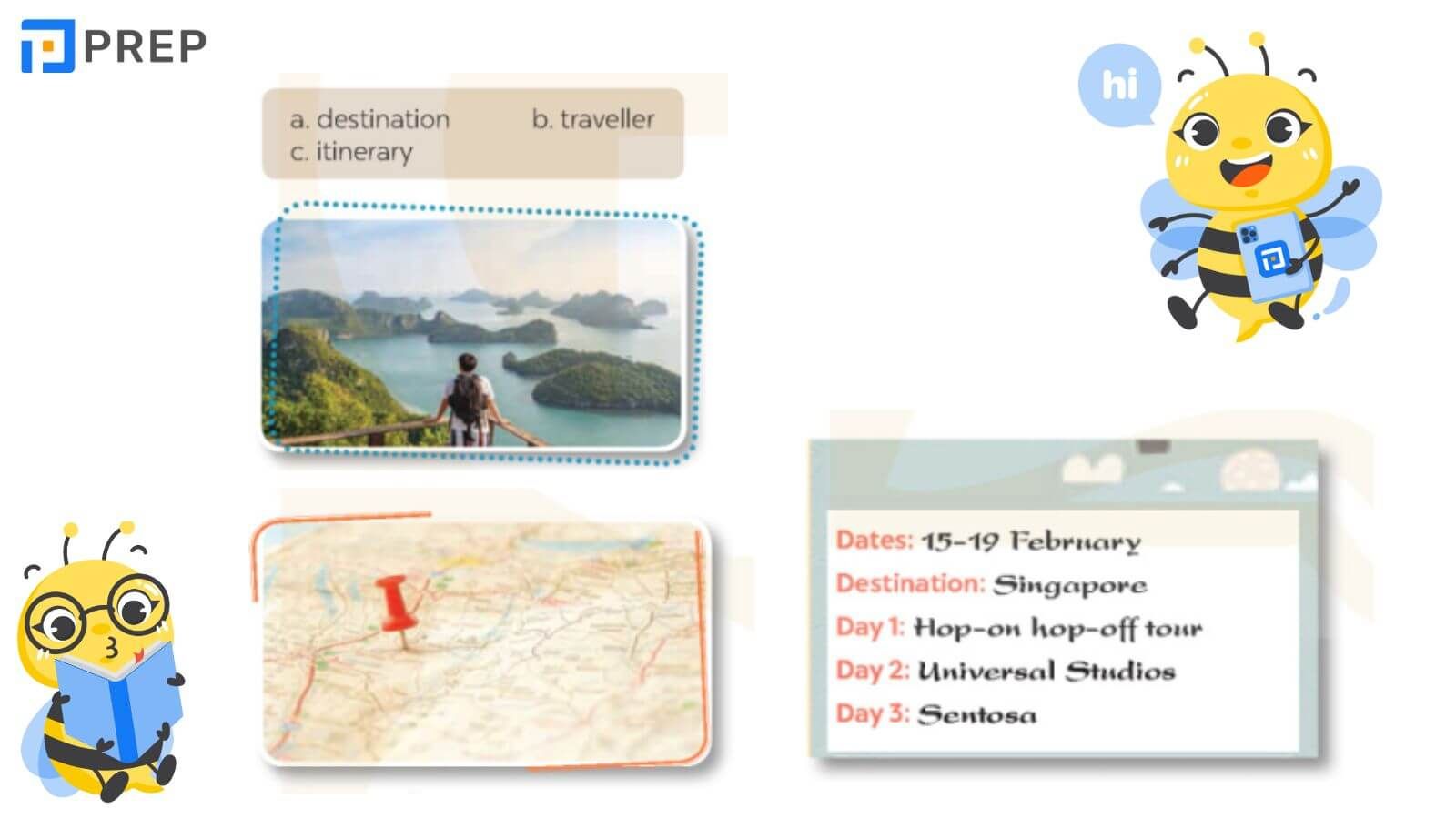
5.2. Read the passage and match the words and phrases in A with the definitions in B
Đọc đoạn văn và nối các từ và cụm từ ở A với định nghĩa ở B.
The two most popular types of tours now are package and self-guided tours.
When you buy a package tour, a travel agency takes care of almost everything for you. You will get a notice about the places of your visit, the detailed itinerary, and the cost. They will protect you if something goes wrong during the trip. This type of holiday saves time and reduces stress for travellers. It offers a convenient option for people who are elderly, who do not want to spend much time searching on their own, or who are not confident about using online apps. One disadvantage of this type is you have to follow a fixed itinerary.
Nowadays, more young people choose self-guided tours which require them to do everything on their own. They have to look for a destination, work out an itinerary, and estimate the cost. They then hunt for tickets and accommodation, usually homestay. This type of holiday may require people more time and effort, but it is cheaper and more flexible than a package holiday. It gives travellers more freedom to decide where to go and how much time and money to spend at a place. However, to have a smooth trip and avoid trouble, these travellers should be good at using apps.
5.3. Read the passage again and answer the questions
Đọc lại đoạn văn và trả lời các câu hỏi.
1. What can a package tour save you?
2. What disadvantage of a package tour does the passage mention?
3. What do travellers have to do on a self-guided tour?
4. What is an advantage of self-guided tours?
5. What skill should you have if you go on a self-guided tour?
5.4. Work in pairs
Làm việc theo cặp. Thay phiên nhau phỏng vấn bạn của bạn về chuyến du lịch gần đây của anh ấy/ cô ấy. Ghi lại câu trả lời của bạn của bạn.
-
Where he/she went (nơi bạn ấy đã đi)
-
Which tourhe/she took package or self-guided (gói du lịch nào mà bạn ấy đã đặt hay tự đi)
-
How he/she travelled (bạn ấy đi bằng phương tiện gì)
-
Where he/she stayed (bạn ấy đã ở đâu)
-
What he/she did/saw (bạn ấy đã làm/ nhìn thấy gì)
5.5. Share with the class your partner's travel experience
Chia sẻ với cả lớp trải nghiệm du lịch của bạn mình. Sau đó bạn có thể chia sẻ những gì bạn nghĩ về nó.
6. Skills 2
6.1. Work in pairs. Discuss if these statements are true
Làm việc theo cặp. Thảo luận xem những tuyên bố này có đúng không.
6.2. A tour guide is announcing the schedule for a one-day trip to the home of the Brontes
Một hướng dẫn viên du lịch đang thông báo lịch trình chuyến đi một ngày đến quê hương của Brontes. Nghe và hoàn thành thông tin còn thiếu.
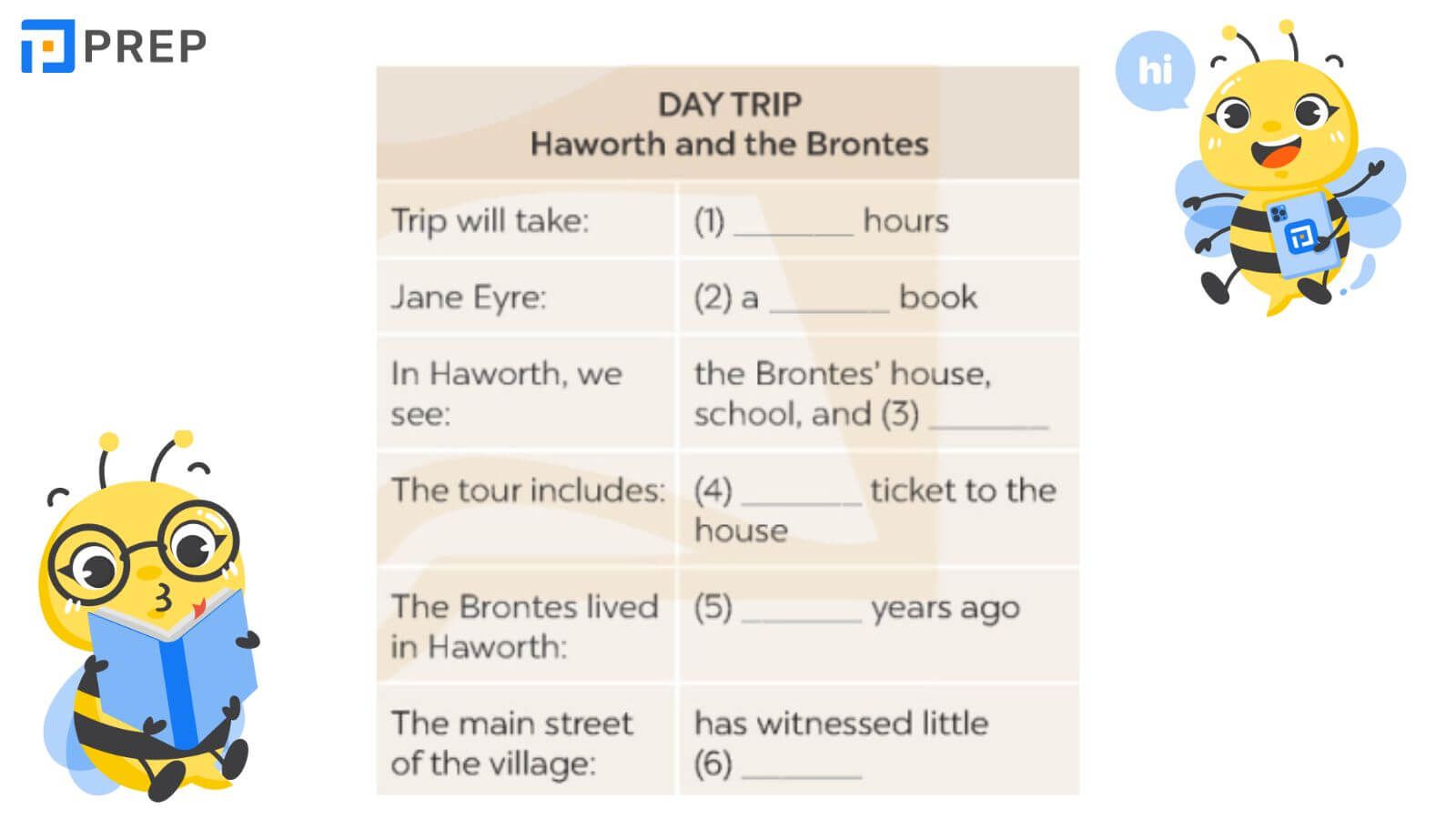
6.3. Look at the pictures, listen again and tick (✔) the two which illustrate the ideas of the listening passage
Nhìn tranh, nghe lại và đánh dấu (✔) vào hai hình minh họa ý của đoạn nghe.
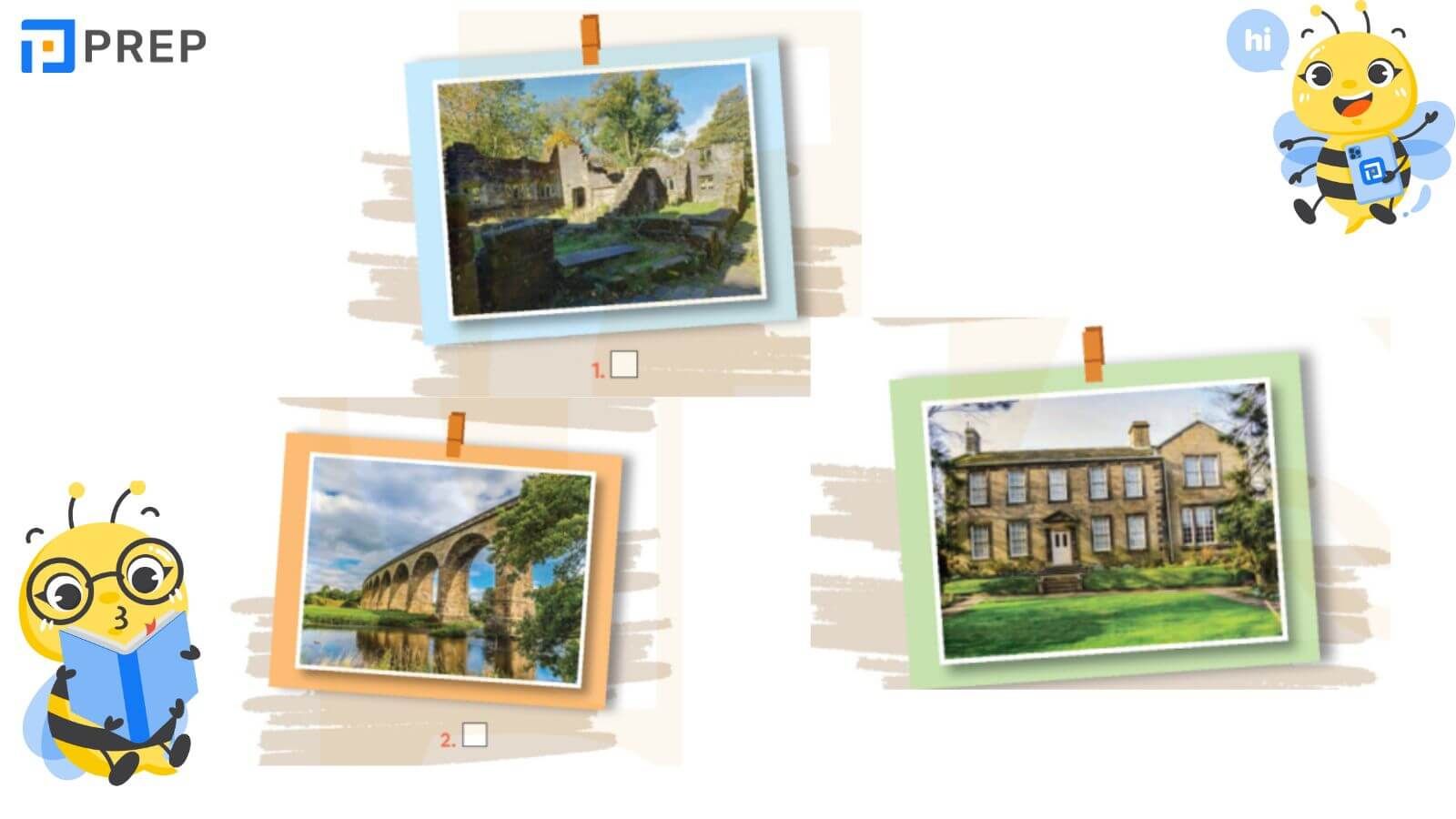
6.4. Work in pairs
Làm việc theo cặp. Thảo luận và đánh dấu (✔) những điều mà hướng dẫn viên du lịch trong đoạn nghe đề cập đến trong thông báo của cô ấy khi bắt đầu chuyến tham quan.
1. The length of the tour (Độ dài của chuyến tham quan)
2. The cost of the tour (Chi phí của chuyến tham quan)
3. The place(s) they visit (Địa điểm họ ghé thăm)
4. Some brief details about each place (Một số thông tin chi tiết ngắn gọn về từng địa điểm)
6.5. Write a paragraph (100-120 words)
Viết một đoạn văn (100-120 từ) giới thiệu về chuyến du lịch Huế nửa ngày này. Sử dụng các manh mối dưới đây.
1. Length of the tour: 5 hours
2. Transportation: mini bus
3. The place(s)
-
Thien Mu Pagoda: oldest pagoda in central and south Viet Nam, built in 1602.
-
The Citadel: see the palace ruins, learn about the history of the Nguyen Dynasty, and visit the altars of the Kings.
-
Dong Ba Market + lunch (at tourists' own expense): biggest market in the city. Get to know about the local products and chat with the locals.
7. Looking Back
7.1. Choose the correct answer A, B, C, or D to complete each sentence
Chọn đáp án đúng A, B, C hoặc D để hoàn thành mỗi câu.
1. If you are travelling abroad for the first time, it's better to look for a good travel _______ to arrange everything for you.
-
A. budget
-
B. agency
-
C. tourism
-
D. homestay
2. Many _______ buildings have become UNESCO World Heritage Sites.
-
A. modern
-
B. domestic
-
C. ruinous
-
D. international
3. Young people are usually good at _______ for cheap transportation and accommodation.
-
A. buying
-
B. booking
-
C. hunting
-
D. applying
4. Nowadays, people can travel on their own to new places by using _______.
-
A. tours
-
B. earphones
-
C. entrance tickets
-
D. Google Maps
5. _______ is for people who love trying different local dishes.
-
A. Food tourism
-
B. Domestic tourism
-
C. Ecotourism
-
D. Shopping tourism
7.2. Fill in each blank with a suitable word or phrase
Điền vào mỗi chỗ trống một từ hoặc cụm từ thích hợp. Chữ cái đầu tiên đã được đưa ra.
1. Would you like to go on an international or a d_______ tour?
2. - Can I make a small change to this itinerary? - I'm afraid not. It's f_______.
3. Thanks to her skills with a_______, she was able to buy cheap tickets to Quy Nhon.
4. They are not experienced enough to go on a s________ tour. They need an adult to go with them.
5. - What did you enjoy most on your tour to Sa Pa? - The n_______ beauty of the mountains and valleys.
7.3. Use a relative pronoun which, who, or whose to complete each sentence
Sử dụng đại từ quan hệ which, who, hoặc who để hoàn thành mỗi câu.
1. Excuse me, could you show me a souvenir shop _______ sells small-size paintings of this city?
2. We can ask my uncle _______ has a lot of experience in organising tours.
3. A visa is a stamp or mark in your passport _______ allows you to enter or leave a foreign country.
4. I'm lost. The hotel I'm staying in is a white multi-storey one ________ name is Islander Hotel.
5. The police officer is talking to the tourist _______ passport is missing.
7.4. Use a relative pronoun which, who, or whose to complete each sentence
Sử dụng đại từ quan hệ which, who, hoặc who để hoàn thành mỗi câu.
1. My family spent four days in India. Its culture is unique.
2. Organising self-guided tours helps develop personal skills. They are important for everybody.
3. Russel stayed in a hotel in Bui Vien Street. It is one of the best streets for foreign tourists.
4. After the Muay Thai Show, my sons talked to the artists. They admired their performance so much.
5. We participated in a lot of activities with the local people. They were friendly and helpful.
8. Project
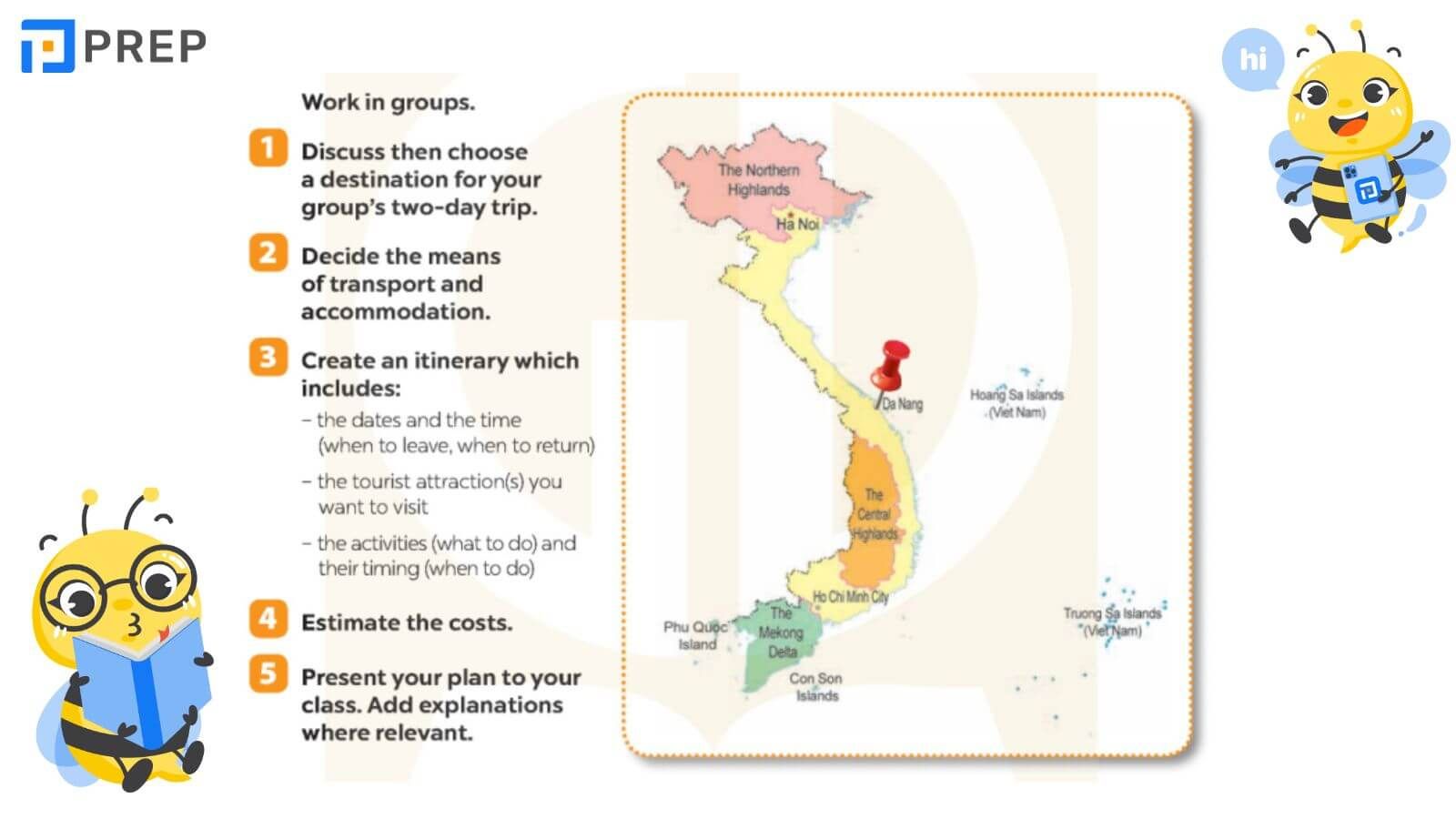
8.1. Discuss then choose a destination for your group's two-day trip
Thảo luận sau đó chọn điểm đến cho chuyến đi hai ngày của nhóm bạn.
8.2. Decide the means of transport and accommodation
Quyết định phương tiện đi lại và chỗ ở.
8.3. Create an itinerary which includes
Lập lịch trình bao gồm:
-
the dates and the time (when to leave, when to return) (ngày và giờ (khi nào đi, khi nào về))
-
the tourist attraction(s) you want to visit ((các) địa điểm du lịch bạn muốn ghé thăm)
-
the activities (what to do) and their timing (when to do) (các hoạt động (làm gì) và thời gian (khi nào làm))
8.4. Estimate the costs
Ước tính chi phí.
8.5. Present your plan to your class
Trình bày kế hoạch của bạn trước lớp. Thêm giải thích khi có liên quan.
IV. Đáp án bài tập tiếng Anh 9 Unit 8
Dưới đây PREP đã sưu tầm đáp án và lời giải gợi ý cho các bài tập trong tiếng Anh Unit 8, tham khảo ngay bạn nhé!
ĐÁP ÁN BÀI TẬP TIẾNG ANH 9 UNIT 8
Trên đây PREP đã chia sẻ đầy đủ từ vựng, ngữ pháp, cấu trúc, kiến thức bài học và đáp án đi kèm trong tiếng Anh 9 Unit 8. Thường xuyên truy cập vào PREP để tham khảo thêm nhiều kiến thức tiếng Anh bổ ích bạn nhé!
Link nội dung: https://khoaqhqt.edu.vn/tieng-anh-9-unit-8-tourism-a57444.html